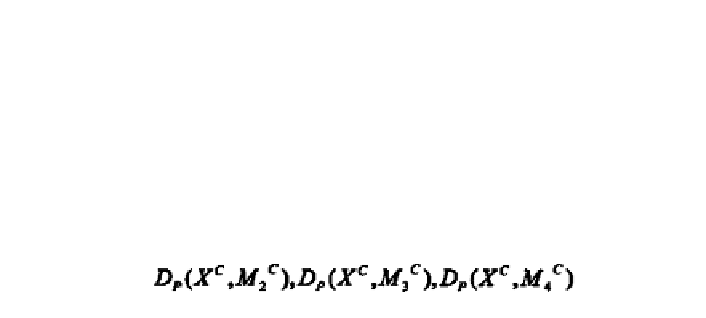Biology Reference
In-Depth Information
inferior surface of the brain), a portion of the skull that can be involved
(but is not necessarily involved) in the various deformities considered.
Here, we report a cross-validation study of the misclassification
rates for the first four measures of dissimilarity described above.
Misclassification rates represent the percent of cases misclassified
after the application of a specific dissimilarity measure. Misclassifi-
cation rates indicate the number of times an individual gets classified
into an incorrect class. If this rate is high, the dissimilarity measure
used is a relatively poor metric for classification, or the data do not pro-
vide adequate information for classifying individuals into the proper
class. In this experiment, we utilized four different measures of dis-
similarity in analysis of the same data set and compared the results.
The steps are provided below with the Unweighted Procrustes distance
given as the dissimilarity measure. The same steps were followed using
each of the four dissimilarity measures. The procedure is as follows:
STEP 1: Pick one of the categories, say sagittal synostosis.
Randomly remove one of the individuals from that sample
and call it
X
.
STEP 2: Estimate the mean form for each of the dysmorphol-
ogy categories.
STEP 3: Compute the dissimilarity measure between the
landmark coordinate matrix for
X
(the individual which was
removed in Step 1) and the estimated mean forms for each of
the dysmorphology categories. For the first group, sagittal
synostosis, calculate
D
P
(
X
C
,
M
1
C
)
=
tr
(
X
C
T
X
C
)
+
tr
(
M
1
C
T
M
1
C
)
-
2
tr
(
X
C
M
C
T
M
1
C
X
C
T
)
1/ 2
where
M
1
is the estimated mean form for the first group
(sagittal synostosis patients). Similarly, compute the dissimi-
larity between individual
X
and the estimated mean forms for
the remaining groups: unicoronal synostosis (
M
2
), metopic
synostosis (
M
3
), posterior plagiocephaly (
M
4
):
STEP 4: Classify the individual into the dysmorphology cate-
gory for which the dissimilarity is the smallest. Check for

Search WWH ::

Custom Search